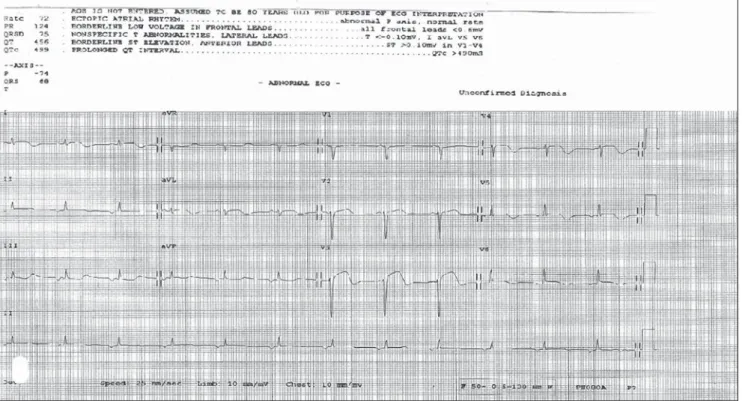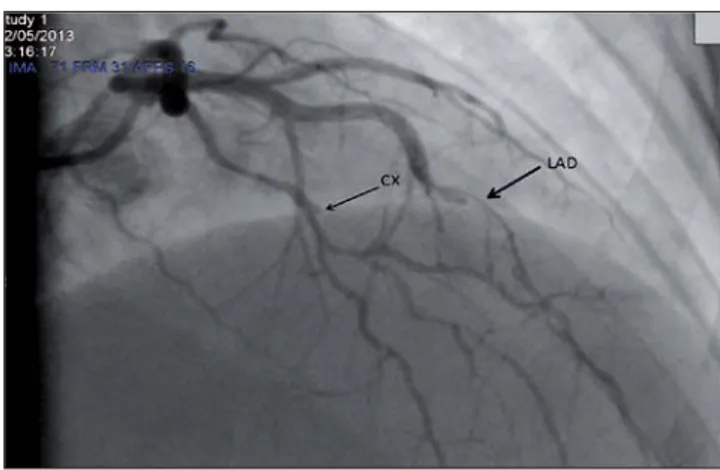Kasuistika
|
Case report
Acute myocardial infarction due to coronary dissection
in early postpartum
Hakan Altay, Didem Oguz, Ersin Doganozu, Seckin Pehlivanoglu
Department of Cardiology, Baskent University Faculty of Medicine, Ankara, TurkeyCor et Vasa
Available online at www.sciencedirect.com
journal homepage: www.elsevier.com/locate/crvasa
Address: Hakan Altay, MD, Department of Cardiology, Baskent University Faculty of Medicine, Oymacı Sok., No 7, 34662 Altunizade, Istanbul, Turkey, e-mail: sakaltay@gmail.com
DOI: 10.1016/j.crvasa.2015.06.003
Please cite this article as: H. Altay, et al., Acute myocardial infarction due to coronary dissection in early postpartum, Cor et Vasa 58 (2016) e448–e450 as published in the online
version of Cor et Vasa available at http://www.sciencedirect.com/science/article/pii/S0010865015000697
ARTICLE INFO Article history: Received: 18. 3. 2015
Received in revised form: 17. 6. 2015 Accepted: 19. 6. 2015
Available online: 17. 7. 2015
SOUHRN
Spontánní disekce koronární tepny je vzácnou, nicméně spolehlivě doloženou příčinou ischemie myokardu. Ve většině případů jde o mladé ženy s několika kardiovaskulárními rizikovými faktory. Spontánní disekce koronární tepny typicky vyvolává rozsáhlý infarkt myokardu a představuje významný problém pro diagnos-tiku a léčbu. Spontánní disekce koronární tepny je nejčastější příčinou ischemie myokardu v období před porodem a po něm u žen v reprodukčním věku.
Tato kasuistika popisuje případ akutního infarktu myokardu přední stěny u kojící ženy, 13 dní po porodu. Předpokládanou příčinou byla disekce ramus interventircularis anterior snižující průtok krve touto koronární tepnou v období před porodem. Stručně popisujeme epidemiologii, patofyziologii, rizikové faktory, diagnó-zu, léčbu a prognózu infarktu myokardu v období těhotenství a po porodu.
© 2015 Published by Elsevier Sp. z o.o. on behalf of the Czech Society of Cardiology. ABSTRACT
Spontaneous coronary artery dissection (SCAD) is a rare but well known cause of myocardial ischemia. The majority of the victims are young who have a few cardiac risk factors. SCAD typically causes large myocardial infarction and presents signifi cant challenges to diagnosis and management. SCAD is the most common cause of myocardial ischemia during peripartum and postpartum period in woman of childbearing age. We present a case of acute anterior myocardial infarction (MI) in a breastfeeding woman, 13 days after delivery. The presumed cause was fl ow limiting left anterior descending (LAD) artery dissection, in the par-ticular context of peripartum. We discuss briefl y the epidemiology, pathophysiology, risk factors, diagnosis, treatment and prognosis of myocardial infarction related to pregnancy and postpartum period.
Klíčová slova:
Disekce koronární tepny Infarkt myokardu Kojení Poporodní období Keywords: Breastfeeding Coronary dissection Myocardial infarction Postpartum
Introduction
Spontaneous coronary artery dissection (SCAD) is a rare but well-known cause of myocardial ischemia. The majority of the victims are young who have a few cardiac risk factors. SCAD typically causes large myocardial infarction and pre-sents signifi cant challenges to diagnosis and management. We describe a case of a postpartum woman with SCAD causing an acute anterior MI who was treated using drug--eluting stent (DES).
Case report
A 39-year-old woman was admitted to emergency de-partment with sudden onset of chest pain, radiating to her back. Thirteen days ago, she had delivered her second child with cesarean section. She had developed gestatio-nal diabetes which was treated with insulin. The postpar-tum period had been eventless and the patient was dis-charged after 2 days. Apart from gestational diabetes, her medical history was unremarkable. She had a history of 20
H. Altay et al.
497
packs-years of smoking and had quit just before pregnan-cy. There were no other known cardiovascular risk factors. On admission, she was clinically stable with a pulse of 75 beats per minute and a blood pressure of 180/90 mmHg.
BMI was 25,5 kg/m2. The ECG showed marked ST segment
elevation in the anterior leads suggesting an acute ante-rior MI (Fig. 1). The patient was given aspirin, sublingual nitrate. Echocardiographic examination ruled out aortic dissection and revealed hypokinesia at the apex, mid and apical walls of anterior and lateral walls of left ventricle with an estimated ejection fraction of 40%. She was im-mediately transferred to the catheter laboratory. The pa-tient was given 600 mg clopidogrel orally and undergone coronary angiography (CAG) immediately.
Coronary angiography showed a fl ow limiting spiral di-ssection and thrombus in mid LAD and a non-fl ow limiting discrete lesion in Circumfl ex (Cx) artery (Fig. 2). DES was implanted successfully to the lesion within the LAD artery. Cardiac enzyme levels were elevated. Upon consultati-on with a pediatrician and discussiconsultati-on with the patient, she stopped breastfeeding and treatment with ACE inhibitor, spironolactone, beta-blocker and statin was started on the second day of presentation. Of note, she was absolutely convinced that these drugs were at most signifi cance for her prognosis and they were dangerous for the baby. She was discharged on 6th day with instructions to take as-pirin, statin, beta-blocker, clopidogrel, ACE inhibitor and spironolactone.
Discussion
The myocardial infarction in pregnancy carries high mor-bidity. The one of most common causes of AMI during
pe-ripartum and postpartum is spontaneous coronary artery dissection (SCAD) which is a rare case in the normal popu-lation. Up to one third of SCAD arise in the third trimester of pregnancy or within 3 months postpartum [1]. The ma-jority of SCAD causes a single-vessel disease. Overall, the LAD is affected in 75% of cases, as in our case, the RCA in 20%, the LCx in about 4% and the left main coronary artery in less than 1% [2]. The incidence of SCAD for the general population with AMI is estimated to be less than 1% [3]. The marked hemodynamic changes during and af-ter delivery add strain on the coronary vessel wall, already weakened by progesterone and estrogen. The alterations in the coagulation and fi brinolysis system resulted in a prothrombotic state. The vulnerability to coronary artery dissection during pregnancy may also relate to the pre-sence of hypertension and also to the changes in elastin and collagen synthesis incurred by the hormonal changes of pregnancy. The most common site of involvement of SCAD is LAD artery [4].
Coronary artery disease is uncommon in women of chi-ldbearing age but pregnancy increases the risk by 4, with an incidence of 3 to 10 per 100,000 deliveries [5]. The inci-dence appears to increase, but whether this refl ects better diagnosis or a real increase remains unclear. Age is an im-portant risk and women over 35 have a 5 times higher risk. Cigarette smoking during pregnancy increases the risk of MI. Other risk factors include diabetes mellitus, hypertensi-on, preeclampsia, postpartum infection and thrombophilia. Coronary emboli may be the other etiology of MI in this patient population, presumably related to the clotting diathesis that occurs during pregnancy. Other non-athe-rosclerotic causes should also be suspected in this patient population, such as ascending aortic dissection, coronary artery spasm, paradoxical emboli.
Fig. 1 – Emergency department electrocardiogram demonstrating marked ST segment elevation in anterolateral leads.
498
Postpartum coronary artery dissectionConclusion
Acute myocardial infarction during pregnancy or the ear-ly post-partum period is rare but increasingear-ly frequent event. Other differential diagnosis and non-atherosclero-tic causes of MI should be thoroughly searched by echo-cardiography. Spontaneous coronary artery dissection should be suspected in this patient population. The tre-atment should be urgent coronary angiography, with a consideration of percutaneous coronary intervention and stenting. Medication should be given taking into conside-ration of both maternal risk as well as foetal or baby risk in breastfeeding woman.
Confl ict of interest
None declared.
Funding body
None.
Ethical statement
Authors state that the research was conducted according to ethical standards.
Informed consent
We have informed consent from the patient for publica-tion of the case and we are grateful to the patient and his/her family for their cooperation. We also declare that there is no image or clue that will enable his/her identity to come out.
References
[1] S. Shahabi, N.A. Smith, C. Chanana, et al., Pregnancy associated myocardial infarction: a report of two cases and review of the literature, Upsala Journal of Medical Sciences 113 (2008) 325–330.
[2] E.A. Thompson, S. Ferraris, T. Gress, V. Ferraris, Gender differences and predictors of mortality in spontaneous coronary artery dissection: a review of the reported cases, Journal of Invasive Cardiology 17 (2005) 59–61.
[3] D.G. Claudon, D.B. Claudon, J.E. Edwards, Primary dissecting aneurysm of coronary artery. A cause of acute myocardial ischemia, Circulation 45 (1972) 259–266.
[4] S.J. DeMaio Jr., S.H. Kinsella, M.E. Silverman, Clinical course and long-term prognosis of spontaneous coronary artery dissection, American Journal of Cardiology 64 (1989) 471–474. [5] A. Roth, U. Elkayam, Acute myocardial infarction associated
with pregnancy, Journal of the American College of Cardiology 52 (2008) 171–180.
[6] A.B. McCann, R.J. Whitbourn, Spontaneous coronary artery dissection: a review of the etiology and available treatment options, Heart Vessels 24 (2009) 463–465.
[7] I. Zupan, M. Noc, D. Trinkaus, et al., Double vessel extension of spontaneous left main coronary artery dissection in young women treated with thrombolysis, Catheterization and Cardiovascular Interventions 52 (2001) 226–230.
[8] B.W. Frey, R.J. Grant, Pregnancy-associated coronary artery dissection: a case report, Journal of Emergency Medicine 30 (2006) 307–310.
[9] P. Bocek, Idiopathic spontaneous coronary artery dissection and drug-eluting stents, International Journal of Cardiology 112 (2006) 367.
The clinical diagnosis of AMI in peripartum is based on symptoms, ECG changes and cardiac markers, as in non--pregnant patients. Other differential diagnosis of chest pain, such as pulmonary embolism, aortic dissection, myo-carditis, Takatsubo cardiomyopathy should be thorough-ly evaluated and excluded. The classic symptom of AMI are severe, crushing substernal chest pain described as a squeezing or constricting sensation with frequent radia-tion to left arm or low jaw. The chest pain usually lasts more than 20 min. Peak intensity is not instantaneous, as it would be with pulmonary embolus or aortic dissection. Echocardiography is a safe and rapid tool for evaluation of these diseases without proceeding directly with CAG. We did echocardiography in our case with the suspicion of aortic dissection which could lead to a catastrophic si-tuation with the use of heparin and clopidogrel during CAG. Bearing in mind that pharmacologic reperfusion either with fi brinolytic or glycoprotein IIb/IIIa antagonist is relatively contraindicated in case of coronary artery di-ssection, the defi nite diagnosis and treatment are based on coronary angiography and mechanical reperfusion. Alt-hough there have been case reports of successfully treated patients with thrombolytics [6], there is also anecdotal and theoretical evidence that thrombolytic agents may further cause extension of dissection plane [7]. It has also been re-commended that using thrombolytics for at least 2 weeks after delivery should be avoided [8]. Treatment with per-cutaneous transluminal angioplasty and bare metal sten-ting where necessary seems reasonable. The safety of drug eluting stents is unknown, and the necessity for prolonged dual antiplatelet therapy makes their use in this context problematic. There are also concerns that DES could de-lay the healing process in the vessel wall of patients with SCAD [9]. Safety of standard treatment in infarction re-mains uncertain for pregnant or breastfeeding patients. Low dose aspirin seems safe, as are nitrates, heparin, nife-dipin and certain beta blockers (metoprolol, atenelol). There are very little data for clopidogrel. ACE inhibitors and angio-tensin receptor blockers are teratogenic; their use in breast-feeding is under debate, as is the prescription of statins.
Fig. 2 – Coronary angiography showing fl ow limiting spiral dissec-tion in LAD and non-fl ow limiting discrete lesion in Cx artery in right cranial view.

